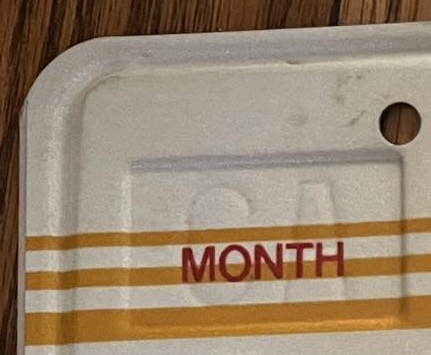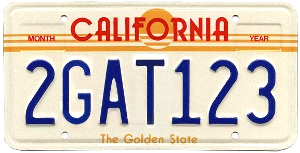
This was issued as an optional design. Until the beginning of 1987, a person registering a new vehicle in California would still, by default, get a normal blue license plate (with the normal yellow lettering). However, if he or she paid an addition 5 dollar fee, the vehicle would be issued a special, artistically-rendered plate design. Many to this day still consider this to be California's best license plate.
License plates issued during this era had raised dark-blue text on a white background. The stylized "CALIFORNIA" across the top was a work of art, with the O in the middle of the word made to look like the setting sun against the horizon of the pacific ocean. The words "The Golden State" appeared at the bottom of the plate, in small yellowish letters placed low enough that they'd be obscured by a license plate frame — for this reason, these plates are officially called "Golden State" plates.
Letters and numeric digits in the license number were both narrow, the same sizes and shapes as the letters and numbers used at the end of the blue plate era. There was enough room for a total of 7 characters plus one half-space. As with the blue plates, the middle crossbar on the E and F was initially short and stubby, and was changed to a long middle crossbar early on in the era (probably at the same time they changed in the blue plates).
At least some of these plates had "CA" debossed in the upper-left sticker well
(the well used for the month):

During this era, blue plates continued to be issued alongside the California sunset plates. Blue passenger plates continued to use license numbers with patterns of the form 1___###, where each _ was a letter and each # was a numeric digit. To avoid overlapping with these combinations, California sunset passenger plates all started with a 2.
Standard California sunset plates issued for passenger cars had license numbers that consisted of the numeric digit 2, followed by 3 letters, followed by 3 numeric digits. No half-space was used between any of these characters. The first such plate issued would have been 2AAA000. As before, the 3 digit group was incremented first, then when they wrapped back around to zeroes the letters were incremented, i.e. the plates would've gone 2AAA000, 2AAA001, 2AAA002, ..., 2AAA999, then 2AAB000, 2AAB001, etc..

Image from
https://japanesenostalgiccar.com/true-history-of-period-correct-california-license-plates/
Blue commercial plates continued to use license numbers with patterns of the form 2_#####. To avoid overlapping with these combinations, California sunset commercial plates all started with a 3.
Standard California sunset plates issued for commercial vehicles had license numbers that consisted of the numeric digit 3, followed by a single letter, followed by 5 numeric digits. No half-space was used between any of these characters. The first such plate issued would have been 3A00000. As before, the 3 digit group was incremented first, then when they wrapped back around to zeroes the letter was incremented, i.e. the plates would've gone 3A00000, 3A00001, 3A00002, ..., 3A99999, then 3B00000, 3B00001, etc..
Blue trailer plates continued to use license numbers with patterns of the form __ ####. To avoid overlapping with these combinations, California sunset trailer plates all added a 1 to the beginning, and (as with the other 7-character combinations) removed the half space. The first such plate issued would have been 1AA0000. As before, the 4 digit group was incremented first, then when they wrapped back around to zeroes the letters were incremented, i.e. the plates would've gone 1AA0000, 1AA0001, 1AA0002, ..., 1AA9999, then 1AB0000, 1AB0001, etc..
Similar to the black and blue trailer plates, California sunset trailer plates issued for commercial weight fee trailers started with 1UA0000, continuing onward. This pattern continued on later plate designs until commercial weight fees were eliminated for trailers in 2001. The pattern was required to end at 1YX8000.
During the California sunset license plate era, exempt plates continued to be indicated by an "E" on the left side of the plate inside an octagon or a diamond — octagon for local governments, diamond for the state government.
The license numbers for these plates consisted entirely of six numeric digits, continuing the pattern from the black and blue license plate eras. Although there were no sticker wells, the words "MONTH" and "YEAR" continued to be printed where the month and year sticker wells would go on a regular non-exempt plate.


Send comments about this webpage to: rogermw@ix.netcom.com.
Go back to my main license plate index page.
Go back to Roger M. Wilcox's homepage.